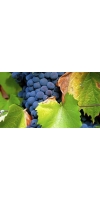Tinta

Tinta is a term that refers to the main red wine grape of Spain. The term refers to Tempranillo, which is native to Spain and is used to create red wines that are typically blended with Grenache and Carinena varieties. The terms for Tinta include Tinta del País, Tinta de Toro and Tinta Fino, which all refer to the Tempranillo variety. The black grape comes from the Spanish word, temprano, meaning early, which refers to the fact that the variety ripens earlier than most red grapes in Spain. Tempranillo was grown in the 20th century to create jug wines in California and has been planted in the United States, South Africa, Turkey, Canada, Australia, and Argentine. Tempranillo grows well at high altitudes and produces deep, ruby colored wines that are aromatic with berry, tobacco, vanilla, plum, herbal, and leather notes. The grape variety was thought to be directly related to Pinot Noir and it was thought that Cistercian monks left cuttings of Pinot Noir at monasteries as they made a pilgrimage to Santiago de Compostela. However, there is no proof that the variety is related to Pinot Noir. Tempranillo grapes need to be grown in cool regions to produce a less acidic wine; however, to create sweet wines that are high in sugar, heat is required. The wine pairs well with steak, a bacon burger, crab, barbecue meats, and pizza with red peppers. Tempranillo also pairs well with veal parmigiana or haddock.
No products found
- back
Selected Options
Grape Types
Categories
Pricing
Countries
Regions
Grape Types
Wineries
Organic/Free Shipping
Tua Rita Giusto di Notri is made from 60% Cabernet Sauvignon, 30% Merlot and 10% Cabernet Franc.
The word "Giusto" refers to the name of the Patron Saint of Suvereto (the hilltop Tuscan town where Tua Rita is located) and "Notri" is the name of the winery's exact location.
Giusto di Notri is a Bordeaux-inspired blend of 60% Cabernet Sauvignon, 30% Merlot and 10% Cabernet Franc, selectively harvested in September. After a gentle pressing, the juice and skins macerate for a lengthy period of 25-30 days to add concentration and depth to the final wine. The wine is then aged for 18-20 months in French oak barrels and refined six months in bottle before release.
Deep purple in color, Giusto di Notri offers abundant aromas of blackberry, plum and currants with underpinnings of coriander, violet and a touch of vanilla. Full-bodied, with ripe, fine tannins, and a silky texture, this is a stunning wine with great aging potential.
Ideal for barbecued ribs, steaks, grilled meats and medium-aged cheeses.
Review:
Lots of incense to the aromas with sandalwood and lavender. Currants, blackberries. and fresh herbs, too. Full-bodied and very rich, with a powerful, structured mid-palate and a long, longfinish. A wine for the future. Needs four to five years to soften. Best after 2026.
-James Suckling 97 Points
Mt Monster Shiraz is 100 percent Shiraz
Deep purple in color. Ripe cassis and black plum fruits on the nose with violets. Varietal fruit-driven palate, with cassis and dark berryfruit and spice flavors. Soft tannins compliment the fruit with mouth-filling generous finish.
French & American oak has been used sparingly to ensure maximum fruit expression is retained in the final wine.
Our Shiraz is fermented in static fermenters at controlled temperatures to retain the varietal aromatics. Once complete the wine is left for 7–10 days on skins to aide in the extraction of soft fleshy tannins and build wine structure.




